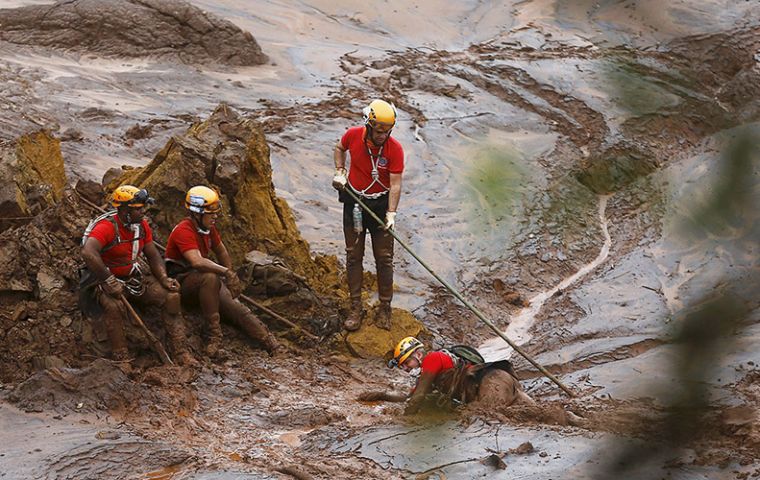MercoPress. South Atlantic News Agency
Mining disaster in Brazil: 28 remain disappeared; BHP Billiton CEO flying to Minas Gerais
 The intensity of the destruction, with flooding and mud as far as 100km away from the mine, has meant a slow and laborious rescue effort.
The intensity of the destruction, with flooding and mud as far as 100km away from the mine, has meant a slow and laborious rescue effort.  BHP said CEO Andrew Mackenzie, was flying to Brazil to meet with Samarco executives and local authorities to better assess their needs.
BHP said CEO Andrew Mackenzie, was flying to Brazil to meet with Samarco executives and local authorities to better assess their needs. Brazilian authorities are still struggling to determine what caused the rupture in dams at an iron ore mine and desperately working to recover the bodies of as many as 28 people believed to have been swept away in the massive mudflow and flood.
Brazilian authorities are still struggling to determine what caused the rupture in dams at an iron ore mine and desperately working to recover the bodies of as many as 28 people believed to have been swept away in the massive mudflow and flood.
From Australia it was announced that BHP Billiton CEO Andrew Mackenzie, was on his way to Brazil since the company is one of the partners in the joint venture mining operation.
The disaster in the mineral-rich southeastern state of Minas Gerais, has prompted a rescue and salvage operation involving about 500 people, many of whom are still searching with the help of dogs and special equipment for victims along the floodplain downstream from the dams.
Authorities late on Sunday recovered two more corpses of possible victims that if confirmed would raise the death toll so far to four. Of the 28 people listed as missing late on Sunday, 13 were mine workers.
The intensity of the destruction, with flooding and mud as far as 100km away from the mine, has meant a slow and laborious rescue effort. It has also sparked calls by government officials, environmentalists and outraged residents for Brazil to rethink regulation of the mining industry, one of the country's biggest and a leading source of export revenue.
“We have to learn the lessons of this accident,” said Fernando Pimentel, the state governor, in comments to reporters after a flyover of the devastation on Sunday. “Obviously, this wasn't enough,” he added, referring to the existing regulatory framework.
Meanwhile, government leaders and residents criticized what they say has been lax communication by mine operator Samarco, a joint venture between the world's largest mining company BHP Billiton Ltd and the biggest iron ore miner, Vale SA.
On Sunday, BHP said Andrew Mackenzie, chief executive officer of the Australian company, was flying to Brazil to meet with Samarco executives and local authorities to better assess their needs. In a statement, the company said it was providing Samarco “with all the assistance necessary”.
Vale, a Brazilian company with a long history of operations in Minas Gerais, has referred all queries about the incident to Samarco.
Displaced residents, whose homes were destroyed or damaged by sludge stained with mineral waste, were especially critical of Samarco for the uncertainty they now face. Authorities said as many as 580 people at present are taking shelter in hotels or with family and friends.
Samarco is paying for accommodations and relocation, but those affected complain that the company has given few answers about how long the displacements might last or how they might eventually repair or replace damaged homes.
Duarte Junior, the mayor of Mariana, the city in which the mine is based, was admitted to hospital early on Sunday for what his wife said could be a heart attack, after nearly three days of emergency work.
While the surge of the waters after Thursday's rupture has receded, authorities are still watching the contaminated residue as it advances through the Rio Doce.
The residue is expected to reach the neighboring state of Espirito Santo by Tuesday.
Until they have a better sense of what might have caused the rupture, authorities are also probing whether indications of possible trouble at the mine might have been ignored.
On Saturday, the Estado de S. Paulo newspaper reported that a study commissioned by the state government in Minas Gerais in 2013 had warned that the dams that burst could be vulnerable.
At a time when iron ore prices have collapsed compared with historic highs in recent years, cleanup and other costs related to the disaster, including regulatory penalties and any litigation Samarco may face, are expected to be high.




Top Comments
Disclaimer & comment rules-

-

-

Read all commentsSounds like another British Petroleum Deep Water Horizon disaster. More British incompetence.
Nov 10th, 2015 - 01:07 am 0Samarcois 50% owned by Vale. A Brazilian company. How does it make it British incompetence?
Nov 10th, 2015 - 04:00 am 0@1 Hippy
Nov 10th, 2015 - 09:43 pm 0No doubt, to you and your peanut-sized brain, it does sound like “another British Petroleum Deep Water Horizon disaster”.
The only problem with your statement is that the company here, is run by Brazilians. Although I'm presuming that the dams were built according to internationally accepted norms, we must remember that the monitoring of the dams for security purposes - if carried out at all - was/is the responsibility of the government of MG....which happens to belong to the PT. So, if incompetence is the main cause for the disaster / tragedy, it is 'local'...
And you Hepatia, will still be stupid in 25 years.
Commenting for this story is now closed.
If you have a Facebook account, become a fan and comment on our Facebook Page!